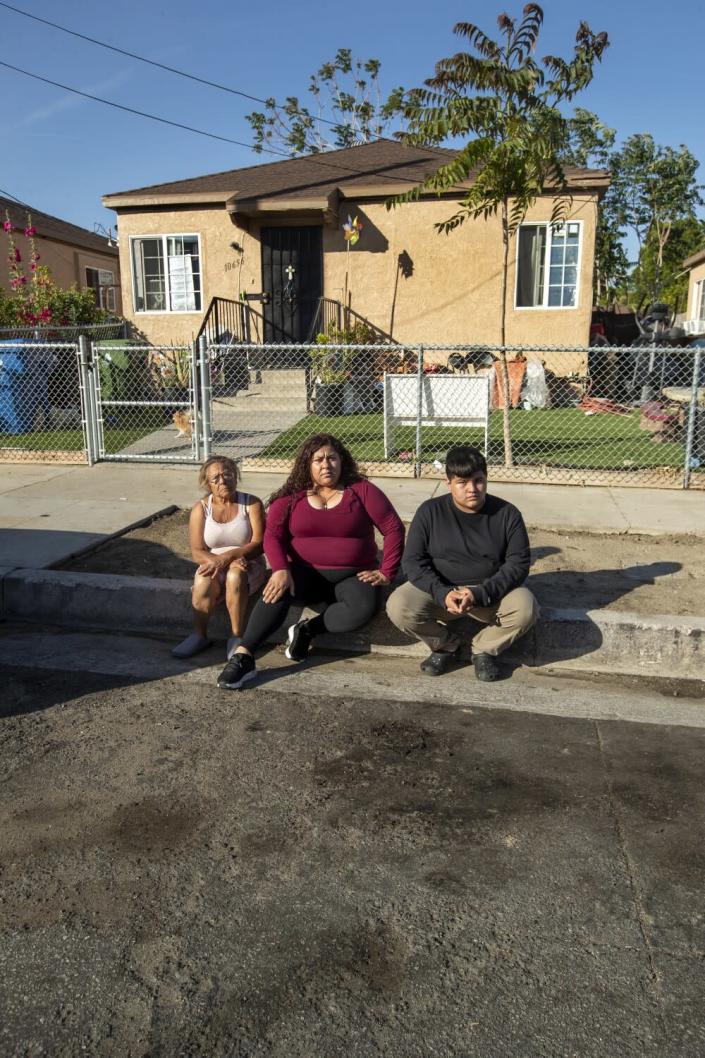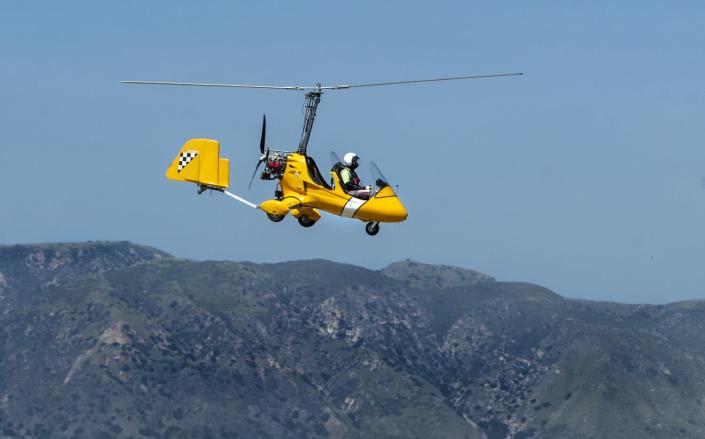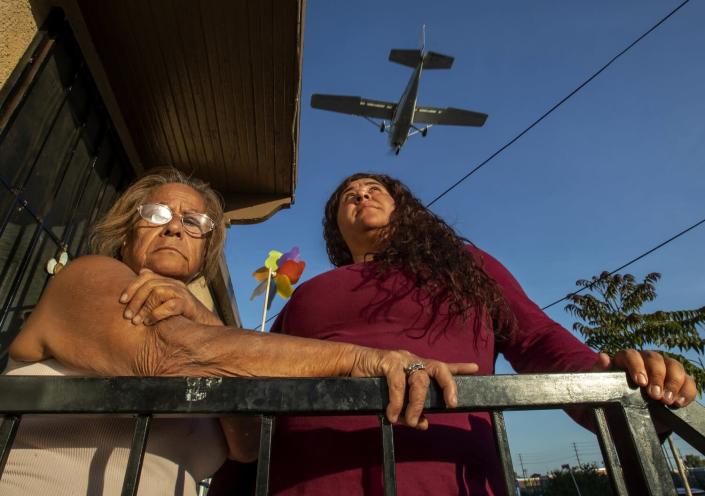After plane crashes and close calls, pressure mounts to close this L.A. airport

The day the plane fell from the sky, Eva Avalos was sipping coffee under her mulberry tree.
Metal flashed in the corner of her eye as the Cessna 182 hit the ground in front of her house and exploded. The tree went up in flames and the heat singed her hair. Her two dogs vanished. She ran to the back of the house with her grandson as the fire spread, then crawled under the chain-link fence to her neighbor’s yard.
Avalos, 68, had just a few bruises from that day in November 2020 and found her Chihuahua Juanita and Shih Tzu-poodle Max hiding safely in their doghouse. But the pilot was killed, and she carries deep emotional scars that rattle her every time she hears the buzz of a plane approaching the runway of Whiteman Airport, just 50 yards from her Pacoima home.
In January, a pilot leaving Whiteman crashed on railroad tracks and barely escaped an oncoming Metrolink train, less than a mile away. Police pulled the bloodied man from the wreckage four seconds before the train barreled into it. Last month, another crashed just feet away from the busy 210 Freeway in Sylmar.
The accidents have provoked outrage among community activists who want the 1940s-era airport shut down. They argue the airport is unsafe and too close to houses and that the leaded fuel used by many planes pollutes the air in a largely low-income Latino community that sees little direct economic benefits. After the January crash, the Los Angeles County Board of Supervisors approved a plan to look at steps needed to close the airport.

Rep. Tony Cárdenas (D-Pacoima), who represents the area, has called on the Federal Aviation Administration to place a 30-day moratorium on all but emergency activities and conduct an audit of the county-run airport’s operations and safety.
“The surrounding community is literally afraid for their lives,” Cárdenas said. “There are way too many crashes coming in and out of Whiteman Airport.”
Over the last decade, there have been 13 crashes at or near Whiteman, one of five general aviation airports owned by Los Angeles County, according to data from the National Transportation Safety Board, which investigates aviation accidents when there is substantial damage to the aircraft, injuries or fatalities. The crashes all involved light aircraft, usually more than three decades old, flown by private pilots. In several cases, the planes wrecked near busy streets or homes.
Safety concerns date back decades. A 1990 county-sponsored study of the airport found “a relatively high number of incidents,” which it blamed on the predominance of recreational and flight-training operations. That report cited more than one accident each year at Whiteman between 1979 and 1990.
Activists who want the airport shut down are encouraged by communities such as Santa Monica, where the airport runway was shortened and cleared for closure by 2028, and San Jose, where the county banned the sale of leaded gasoline at the airport.
But the thought of losing an airstrip troubles aviation enthusiasts. Whiteman caters to pilot hobbyists, commuters and flight students.
“Where would all those airplanes go? There are still people that need to do training,” said Dave Kolstad, a retired management consultant who stores an airplane he built 40 years ago inside a hangar at the airport. He notes that the aviation industry is struggling with a shortage of pilots.
As the treasurer of the Whiteman Airport Assn. and the local chapter of the Experimental Aircraft Assn., Kolstad said he has taken hundreds of children on flights as part of a free youth program at the airport.
“The accident rate in aviation is so low,” Kolstad said. “Car accidents don’t get reported because they are so routine.”

Thomas Anthony, director of the aviation and security program at USC, said the type of planes going out of Whiteman rarely have widespread catastrophes like those of commercial flights.
“Cessna or Pipers are extremely light,” he said. “The amount of damage that they can do is sort of like the amount of damage a motor scooter or a motorcycle can do.”
Most often those injured or killed are in the aircraft, he said.
In 2020, 332 people died in general aviation crashes, but overall deaths have been on the decline, according to U.S. Bureau of Transportation Statistics.
Nobody on the ground, Kolstad said, has been killed at Whiteman in recent memory.
But activists say it’s a matter of time. Operations at the airport grew 13.7% between 2014 and 2018. And experts say the growth of air taxis could only put smaller airports in greater demand.
“Driving an airplane above disadvantaged communities is a luxury,” said Veronica Padilla-Campos, executive director of Pacoima Beautiful, a community advocacy group. “It’s not the same as driving a car. That is a necessity to get to schools, to work, to everyday life.”
Safety isn’t her only worry. The nonprofit group is working with researchers from USC to test for lead in soils around the airport. While most commercial airlines don’t use leaded fuel and it has long been phased out of road vehicle gasoline, it still powers piston-engine aircraft and helicopters that fly in general aviation airports. The EPA has found higher concentrations of lead at or downwind of these airports and is investigating whether they are a threat to public health. Lead has been shown to hurt child development, and the Environmental Protection Agency has been evaluating its concentration levels near airports.

The airport was founded in 1946 on a farm by sportsman pilot Marvin Whiteman Sr. and bought by the county in 1970. The 184-acre airport now sits in a neighborhood packed tightly with homes, apartments, equipment yards, warehouses and factories. Avalos listens to trains barreling along the Union Pacific tracks a block away, and just beyond that, the big rigs endlessly rumbling on San Fernando Road.
Add to that urban drone: 320 takeoffs and landings daily at the airport, used not just by private pilots, but by the Los Angeles County Sheriff’s and Fire departments and television news helicopters.
Whiteman’s accident rate is higher than that of most of its neighbors, but on par with Chino’s airport and only marginally worse than Fullerton’s, with 12 accidents between 2012 and 2022. Other airports run by Los Angeles County all had fewer accidents. El Monte’s had eight, La Verne’s airport had 10, Compton’s had six and Lancaster’s had seven.
Steven Frasher, a spokesman for the Los Angeles County Department of Public Works, which operates the airport, said just because these crashes have occurred doesn’t mean that the airport infrastructure is to blame.
“They weren’t airport facility-related,” he said. “Anytime there’s an incident we’re going to be concerned about, certainly the person impacted both on the ground and whoever was aboard the aircraft, and looking for answers as to what may have been a contributing factor. “
Avalos said nobody from the airport came to speak with her about the accident in front of her home. The plane had clipped a tree and a power pole, cutting electricity to the neighborhood, before it landed upside down on her street, setting her yard and two parked cars ablaze.
Her grandson, Ethan Vasquez Lopez, 12, still recalls the lights flickering and the boom of the crash that day. He ran out of the house to see what happened. He heard the pilot’s call for help before seeing him and the plane get engulfed in flames. He can’t get the gruesome moment out of his mind.
The burnt chemical smell hung over their home for days.
His mother, Margarita Lopez, 31, was out shopping when the plane hit. “I could have lost my only son and my only mom,” she said. “I get choked up thinking about it.”
All three haven’t slept peacefully ever since.

“I am still so traumatized,” said Avalos. She can still see the burned body of the pilot.
They have looked for other housing, but their rent is only $1,040, saying they can’t afford a new deposit.
After the wreck, the Los Angeles City Council voted to support any legislation that would shut down the airport and approved a process that Councilwoman Monica Rodriguez, who represents the area, hopes will eventually lead to its closing.
But any effort to close the airport could be stymied by agreements that Los Angeles County made with the FAA. Since 2006, Los Angeles County has received $4.8 million in airport improvement grants for Whiteman, most recently in 2021. Under the grant conditions, operators must keep the airport open for at least 20 years from the date of the most recent grant.
FAA spokesman Ian Gregor said the county has this obligation and that the FAA has not received a request for closure.
In December 2020, the county created a community advisory committee — made up of airport officials, community members, business owners and flight enthusiasts— to come up with a plan for the airport that would address some of the community’s concerns.
The advisory board is set to make recommendations later this year on the future of Whiteman, but some members say meetings are often contentious and key data, including reports on the accident in front of Avalos’ home, are still unavailable.

Padilla-Campos said that the committee hasn’t really been able to do true community outreach with coronavirus concerns and that she often feels her worries are dismissed.
Frasher, who represents the county, said it is trying to repair fractured relations. “The airport operators and vendors and pilots associations at Whiteman are all hoping to make a better connection with the community.”
On a clear spring day recently, the sputtering buzz of small planes continued.
Lopez stepped out of her home. The now-melted chair that her mom had been sitting on the day of the crash still sat on the artificial lawn. The burned-up mulberry tree had been removed.
“See how close they get,” she told a reporter. A plane flew low over her house and landed on the runway across the street.
“Feel my heart. It’s racing,” she said. “You relive it every day. You live in fear.”
This story originally appeared in Los Angeles Times.






